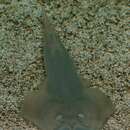Life Cycle
provided by Fishbase
Exhibit ovoviparity (aplacental viviparity), with embryos feeding initially on yolk, then receiving additional nourishment from the mother by indirect absorption of uterine fluid enriched with mucus, fat or protein through specialised structures (Ref. 50449). Born at 38-40 cm TL (Ref.58048).
Trophic Strategy
provided by Fishbase
Adults found on the continental shelf down to 100 m. Juveniles found inshore around atolls, in mangrove swamps and occasionally enter estuaries . Feeds on shellfish. Reported to live and breed permanently in freshwater.
- Recorder
- Drina Sta. Iglesia
Biology
provided by Fishbase
Occurs inshore and offshore, from the intertidal to offshore continental and insular shelves (Ref. 9909). Adults are found offshore waters while young individuals are found inshore on sand flats, around atolls, and in mangrove swamps (Ref. 6871). Feeds on shellfish, mainly on prawns and crabs (Ref. 9909, Ref. 114953). Ovoviviparous (Ref. 50449). Maturity size at 150-180 cm TL; born at 38-40 cm TL (Ref. 114953). Reported to live and breed permanently in fresh water (Ref. 6871). Probably the major commercial guitarfish in the Western Central Pacific (Ref. 9909). Caught regularly by demersal tangle net fisheries operating throughout the area. Utilized for its meat, fins (both very high value), skin and cartilage (Ref.58048). Reported to attain a maximum length of 4 m (Ref. 58784).
Importance
provided by Fishbase
fisheries: minor commercial; aquarium: commercial; price category: low; price reliability: questionable: based on ex-vessel price for species in this genus

